Construction Law
VerifiedAdded on 2022/11/25
|12
|3776
|415
AI Summary
This article provides expert advice on construction law and addresses issues of negligence in construction works. It discusses duty of care, breach of contract, and the process of claiming damages.
Contribute Materials
Your contribution can guide someone’s learning journey. Share your
documents today.
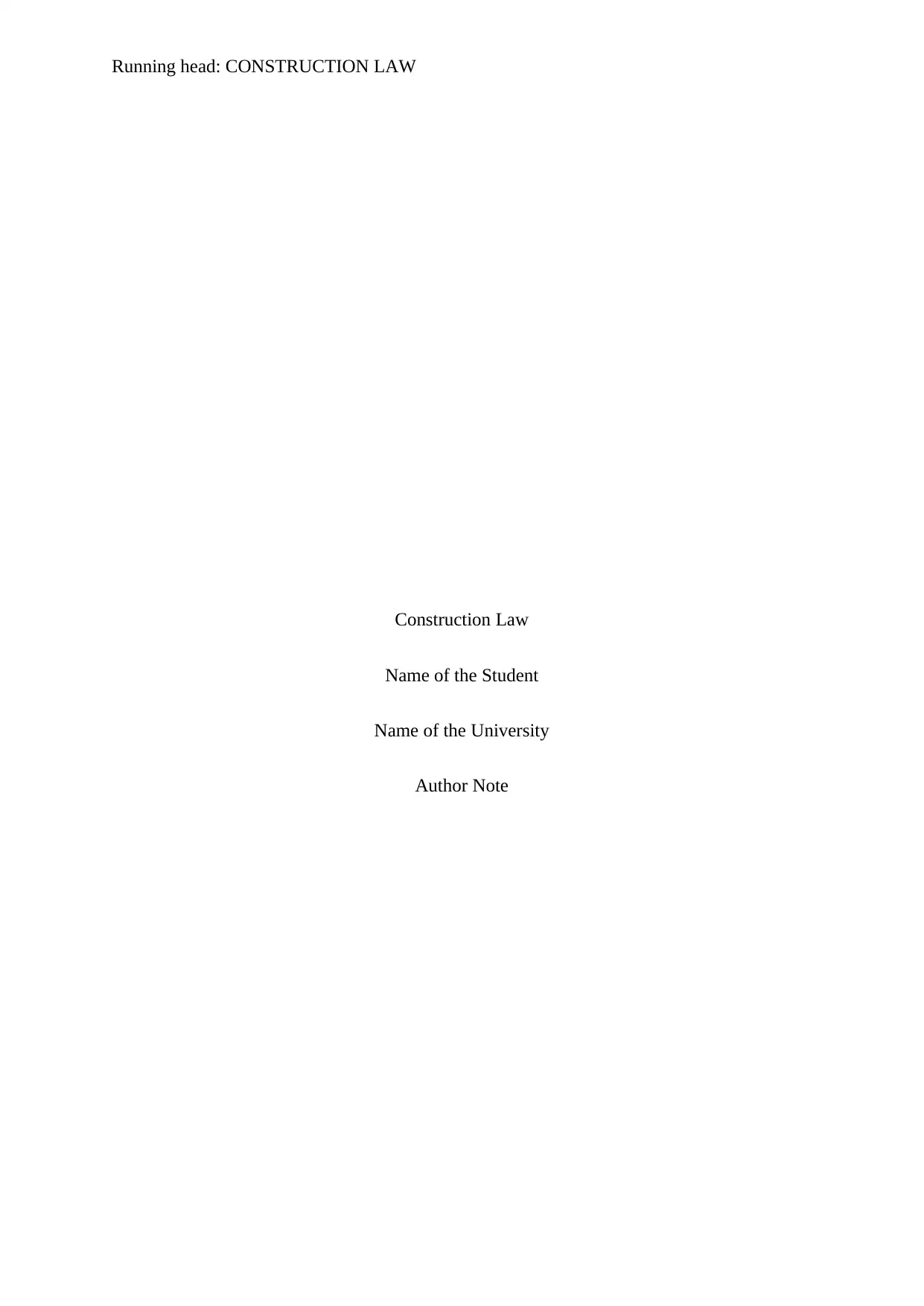
Running head: CONSTRUCTION LAW
Construction Law
Name of the Student
Name of the University
Author Note
Construction Law
Name of the Student
Name of the University
Author Note
Secure Best Marks with AI Grader
Need help grading? Try our AI Grader for instant feedback on your assignments.
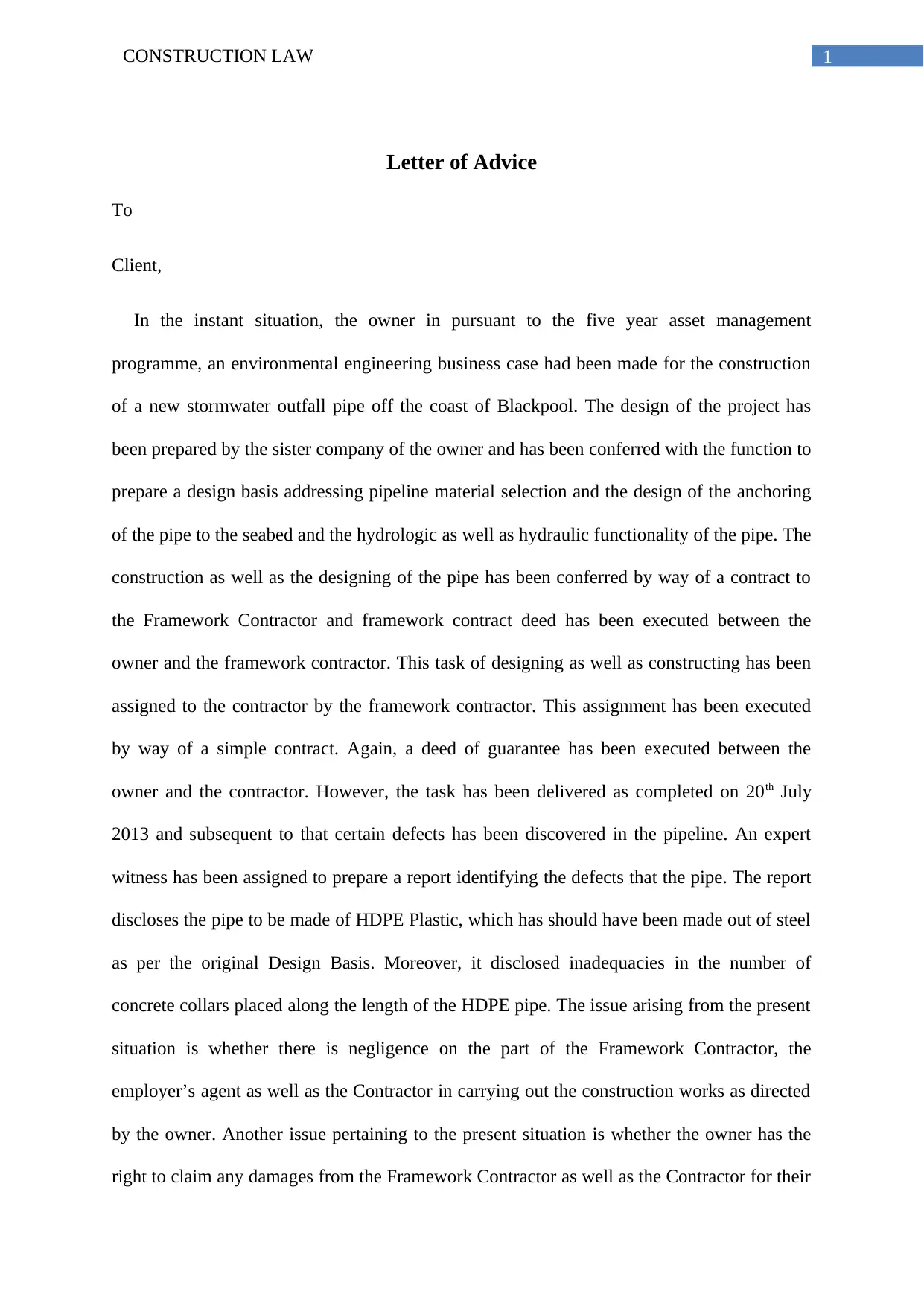
1CONSTRUCTION LAW
Letter of Advice
To
Client,
In the instant situation, the owner in pursuant to the five year asset management
programme, an environmental engineering business case had been made for the construction
of a new stormwater outfall pipe off the coast of Blackpool. The design of the project has
been prepared by the sister company of the owner and has been conferred with the function to
prepare a design basis addressing pipeline material selection and the design of the anchoring
of the pipe to the seabed and the hydrologic as well as hydraulic functionality of the pipe. The
construction as well as the designing of the pipe has been conferred by way of a contract to
the Framework Contractor and framework contract deed has been executed between the
owner and the framework contractor. This task of designing as well as constructing has been
assigned to the contractor by the framework contractor. This assignment has been executed
by way of a simple contract. Again, a deed of guarantee has been executed between the
owner and the contractor. However, the task has been delivered as completed on 20th July
2013 and subsequent to that certain defects has been discovered in the pipeline. An expert
witness has been assigned to prepare a report identifying the defects that the pipe. The report
discloses the pipe to be made of HDPE Plastic, which has should have been made out of steel
as per the original Design Basis. Moreover, it disclosed inadequacies in the number of
concrete collars placed along the length of the HDPE pipe. The issue arising from the present
situation is whether there is negligence on the part of the Framework Contractor, the
employer’s agent as well as the Contractor in carrying out the construction works as directed
by the owner. Another issue pertaining to the present situation is whether the owner has the
right to claim any damages from the Framework Contractor as well as the Contractor for their
Letter of Advice
To
Client,
In the instant situation, the owner in pursuant to the five year asset management
programme, an environmental engineering business case had been made for the construction
of a new stormwater outfall pipe off the coast of Blackpool. The design of the project has
been prepared by the sister company of the owner and has been conferred with the function to
prepare a design basis addressing pipeline material selection and the design of the anchoring
of the pipe to the seabed and the hydrologic as well as hydraulic functionality of the pipe. The
construction as well as the designing of the pipe has been conferred by way of a contract to
the Framework Contractor and framework contract deed has been executed between the
owner and the framework contractor. This task of designing as well as constructing has been
assigned to the contractor by the framework contractor. This assignment has been executed
by way of a simple contract. Again, a deed of guarantee has been executed between the
owner and the contractor. However, the task has been delivered as completed on 20th July
2013 and subsequent to that certain defects has been discovered in the pipeline. An expert
witness has been assigned to prepare a report identifying the defects that the pipe. The report
discloses the pipe to be made of HDPE Plastic, which has should have been made out of steel
as per the original Design Basis. Moreover, it disclosed inadequacies in the number of
concrete collars placed along the length of the HDPE pipe. The issue arising from the present
situation is whether there is negligence on the part of the Framework Contractor, the
employer’s agent as well as the Contractor in carrying out the construction works as directed
by the owner. Another issue pertaining to the present situation is whether the owner has the
right to claim any damages from the Framework Contractor as well as the Contractor for their
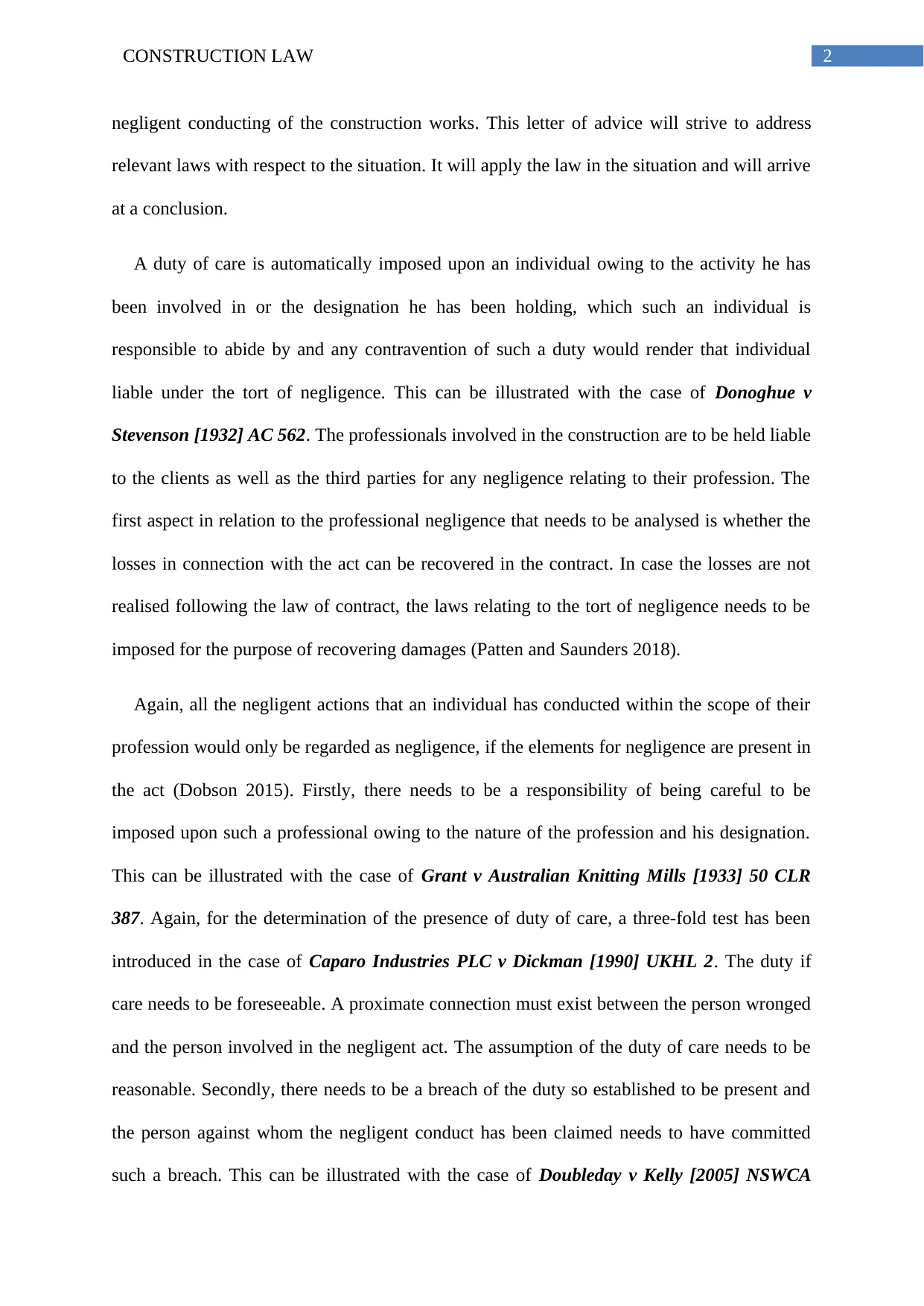
2CONSTRUCTION LAW
negligent conducting of the construction works. This letter of advice will strive to address
relevant laws with respect to the situation. It will apply the law in the situation and will arrive
at a conclusion.
A duty of care is automatically imposed upon an individual owing to the activity he has
been involved in or the designation he has been holding, which such an individual is
responsible to abide by and any contravention of such a duty would render that individual
liable under the tort of negligence. This can be illustrated with the case of Donoghue v
Stevenson [1932] AC 562. The professionals involved in the construction are to be held liable
to the clients as well as the third parties for any negligence relating to their profession. The
first aspect in relation to the professional negligence that needs to be analysed is whether the
losses in connection with the act can be recovered in the contract. In case the losses are not
realised following the law of contract, the laws relating to the tort of negligence needs to be
imposed for the purpose of recovering damages (Patten and Saunders 2018).
Again, all the negligent actions that an individual has conducted within the scope of their
profession would only be regarded as negligence, if the elements for negligence are present in
the act (Dobson 2015). Firstly, there needs to be a responsibility of being careful to be
imposed upon such a professional owing to the nature of the profession and his designation.
This can be illustrated with the case of Grant v Australian Knitting Mills [1933] 50 CLR
387. Again, for the determination of the presence of duty of care, a three-fold test has been
introduced in the case of Caparo Industries PLC v Dickman [1990] UKHL 2. The duty if
care needs to be foreseeable. A proximate connection must exist between the person wronged
and the person involved in the negligent act. The assumption of the duty of care needs to be
reasonable. Secondly, there needs to be a breach of the duty so established to be present and
the person against whom the negligent conduct has been claimed needs to have committed
such a breach. This can be illustrated with the case of Doubleday v Kelly [2005] NSWCA
negligent conducting of the construction works. This letter of advice will strive to address
relevant laws with respect to the situation. It will apply the law in the situation and will arrive
at a conclusion.
A duty of care is automatically imposed upon an individual owing to the activity he has
been involved in or the designation he has been holding, which such an individual is
responsible to abide by and any contravention of such a duty would render that individual
liable under the tort of negligence. This can be illustrated with the case of Donoghue v
Stevenson [1932] AC 562. The professionals involved in the construction are to be held liable
to the clients as well as the third parties for any negligence relating to their profession. The
first aspect in relation to the professional negligence that needs to be analysed is whether the
losses in connection with the act can be recovered in the contract. In case the losses are not
realised following the law of contract, the laws relating to the tort of negligence needs to be
imposed for the purpose of recovering damages (Patten and Saunders 2018).
Again, all the negligent actions that an individual has conducted within the scope of their
profession would only be regarded as negligence, if the elements for negligence are present in
the act (Dobson 2015). Firstly, there needs to be a responsibility of being careful to be
imposed upon such a professional owing to the nature of the profession and his designation.
This can be illustrated with the case of Grant v Australian Knitting Mills [1933] 50 CLR
387. Again, for the determination of the presence of duty of care, a three-fold test has been
introduced in the case of Caparo Industries PLC v Dickman [1990] UKHL 2. The duty if
care needs to be foreseeable. A proximate connection must exist between the person wronged
and the person involved in the negligent act. The assumption of the duty of care needs to be
reasonable. Secondly, there needs to be a breach of the duty so established to be present and
the person against whom the negligent conduct has been claimed needs to have committed
such a breach. This can be illustrated with the case of Doubleday v Kelly [2005] NSWCA
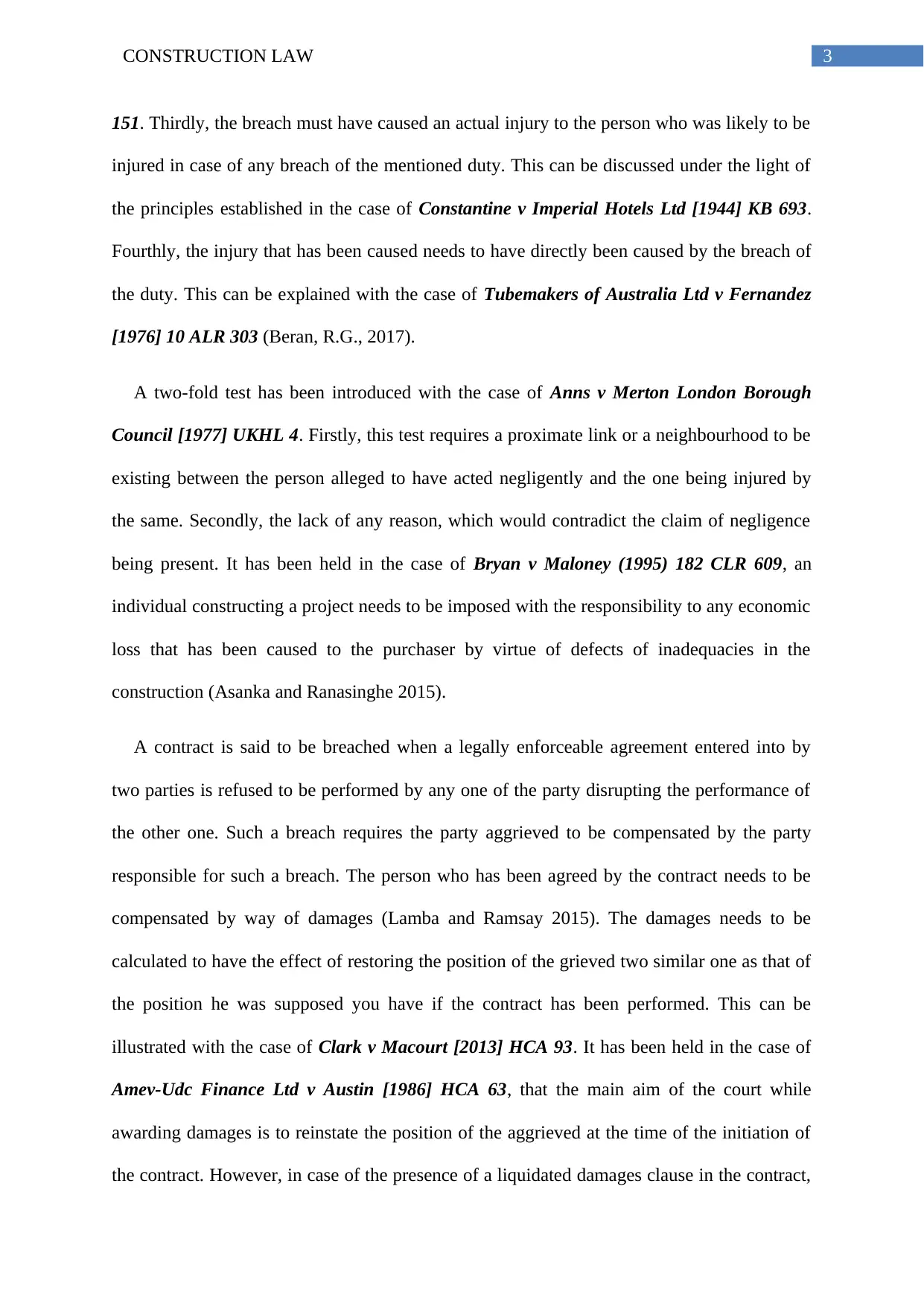
3CONSTRUCTION LAW
151. Thirdly, the breach must have caused an actual injury to the person who was likely to be
injured in case of any breach of the mentioned duty. This can be discussed under the light of
the principles established in the case of Constantine v Imperial Hotels Ltd [1944] KB 693.
Fourthly, the injury that has been caused needs to have directly been caused by the breach of
the duty. This can be explained with the case of Tubemakers of Australia Ltd v Fernandez
[1976] 10 ALR 303 (Beran, R.G., 2017).
A two-fold test has been introduced with the case of Anns v Merton London Borough
Council [1977] UKHL 4. Firstly, this test requires a proximate link or a neighbourhood to be
existing between the person alleged to have acted negligently and the one being injured by
the same. Secondly, the lack of any reason, which would contradict the claim of negligence
being present. It has been held in the case of Bryan v Maloney (1995) 182 CLR 609, an
individual constructing a project needs to be imposed with the responsibility to any economic
loss that has been caused to the purchaser by virtue of defects of inadequacies in the
construction (Asanka and Ranasinghe 2015).
A contract is said to be breached when a legally enforceable agreement entered into by
two parties is refused to be performed by any one of the party disrupting the performance of
the other one. Such a breach requires the party aggrieved to be compensated by the party
responsible for such a breach. The person who has been agreed by the contract needs to be
compensated by way of damages (Lamba and Ramsay 2015). The damages needs to be
calculated to have the effect of restoring the position of the grieved two similar one as that of
the position he was supposed you have if the contract has been performed. This can be
illustrated with the case of Clark v Macourt [2013] HCA 93. It has been held in the case of
Amev-Udc Finance Ltd v Austin [1986] HCA 63, that the main aim of the court while
awarding damages is to reinstate the position of the aggrieved at the time of the initiation of
the contract. However, in case of the presence of a liquidated damages clause in the contract,
151. Thirdly, the breach must have caused an actual injury to the person who was likely to be
injured in case of any breach of the mentioned duty. This can be discussed under the light of
the principles established in the case of Constantine v Imperial Hotels Ltd [1944] KB 693.
Fourthly, the injury that has been caused needs to have directly been caused by the breach of
the duty. This can be explained with the case of Tubemakers of Australia Ltd v Fernandez
[1976] 10 ALR 303 (Beran, R.G., 2017).
A two-fold test has been introduced with the case of Anns v Merton London Borough
Council [1977] UKHL 4. Firstly, this test requires a proximate link or a neighbourhood to be
existing between the person alleged to have acted negligently and the one being injured by
the same. Secondly, the lack of any reason, which would contradict the claim of negligence
being present. It has been held in the case of Bryan v Maloney (1995) 182 CLR 609, an
individual constructing a project needs to be imposed with the responsibility to any economic
loss that has been caused to the purchaser by virtue of defects of inadequacies in the
construction (Asanka and Ranasinghe 2015).
A contract is said to be breached when a legally enforceable agreement entered into by
two parties is refused to be performed by any one of the party disrupting the performance of
the other one. Such a breach requires the party aggrieved to be compensated by the party
responsible for such a breach. The person who has been agreed by the contract needs to be
compensated by way of damages (Lamba and Ramsay 2015). The damages needs to be
calculated to have the effect of restoring the position of the grieved two similar one as that of
the position he was supposed you have if the contract has been performed. This can be
illustrated with the case of Clark v Macourt [2013] HCA 93. It has been held in the case of
Amev-Udc Finance Ltd v Austin [1986] HCA 63, that the main aim of the court while
awarding damages is to reinstate the position of the aggrieved at the time of the initiation of
the contract. However, in case of the presence of a liquidated damages clause in the contract,
Secure Best Marks with AI Grader
Need help grading? Try our AI Grader for instant feedback on your assignments.
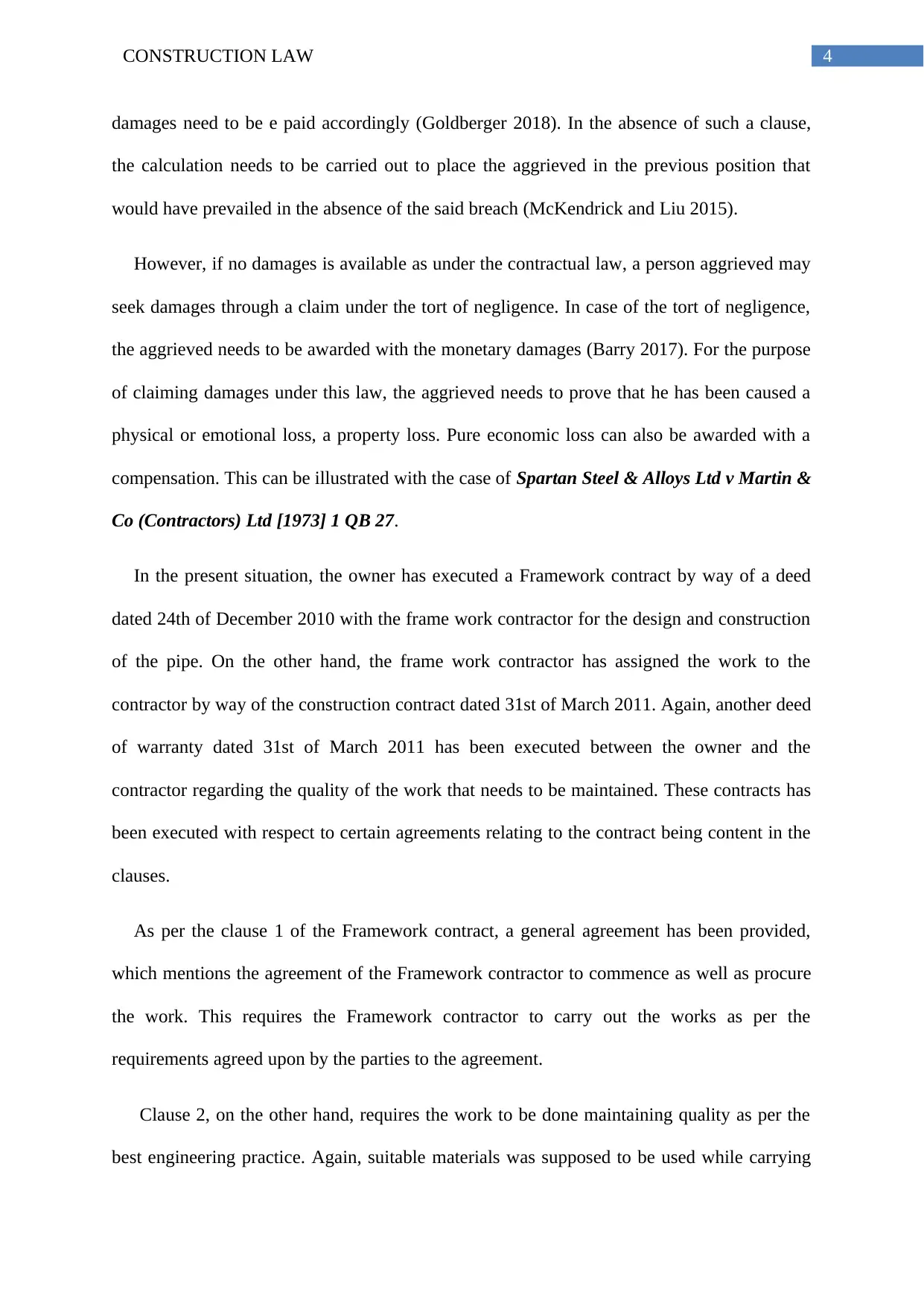
4CONSTRUCTION LAW
damages need to be e paid accordingly (Goldberger 2018). In the absence of such a clause,
the calculation needs to be carried out to place the aggrieved in the previous position that
would have prevailed in the absence of the said breach (McKendrick and Liu 2015).
However, if no damages is available as under the contractual law, a person aggrieved may
seek damages through a claim under the tort of negligence. In case of the tort of negligence,
the aggrieved needs to be awarded with the monetary damages (Barry 2017). For the purpose
of claiming damages under this law, the aggrieved needs to prove that he has been caused a
physical or emotional loss, a property loss. Pure economic loss can also be awarded with a
compensation. This can be illustrated with the case of Spartan Steel & Alloys Ltd v Martin &
Co (Contractors) Ltd [1973] 1 QB 27.
In the present situation, the owner has executed a Framework contract by way of a deed
dated 24th of December 2010 with the frame work contractor for the design and construction
of the pipe. On the other hand, the frame work contractor has assigned the work to the
contractor by way of the construction contract dated 31st of March 2011. Again, another deed
of warranty dated 31st of March 2011 has been executed between the owner and the
contractor regarding the quality of the work that needs to be maintained. These contracts has
been executed with respect to certain agreements relating to the contract being content in the
clauses.
As per the clause 1 of the Framework contract, a general agreement has been provided,
which mentions the agreement of the Framework contractor to commence as well as procure
the work. This requires the Framework contractor to carry out the works as per the
requirements agreed upon by the parties to the agreement.
Clause 2, on the other hand, requires the work to be done maintaining quality as per the
best engineering practice. Again, suitable materials was supposed to be used while carrying
damages need to be e paid accordingly (Goldberger 2018). In the absence of such a clause,
the calculation needs to be carried out to place the aggrieved in the previous position that
would have prevailed in the absence of the said breach (McKendrick and Liu 2015).
However, if no damages is available as under the contractual law, a person aggrieved may
seek damages through a claim under the tort of negligence. In case of the tort of negligence,
the aggrieved needs to be awarded with the monetary damages (Barry 2017). For the purpose
of claiming damages under this law, the aggrieved needs to prove that he has been caused a
physical or emotional loss, a property loss. Pure economic loss can also be awarded with a
compensation. This can be illustrated with the case of Spartan Steel & Alloys Ltd v Martin &
Co (Contractors) Ltd [1973] 1 QB 27.
In the present situation, the owner has executed a Framework contract by way of a deed
dated 24th of December 2010 with the frame work contractor for the design and construction
of the pipe. On the other hand, the frame work contractor has assigned the work to the
contractor by way of the construction contract dated 31st of March 2011. Again, another deed
of warranty dated 31st of March 2011 has been executed between the owner and the
contractor regarding the quality of the work that needs to be maintained. These contracts has
been executed with respect to certain agreements relating to the contract being content in the
clauses.
As per the clause 1 of the Framework contract, a general agreement has been provided,
which mentions the agreement of the Framework contractor to commence as well as procure
the work. This requires the Framework contractor to carry out the works as per the
requirements agreed upon by the parties to the agreement.
Clause 2, on the other hand, requires the work to be done maintaining quality as per the
best engineering practice. Again, suitable materials was supposed to be used while carrying
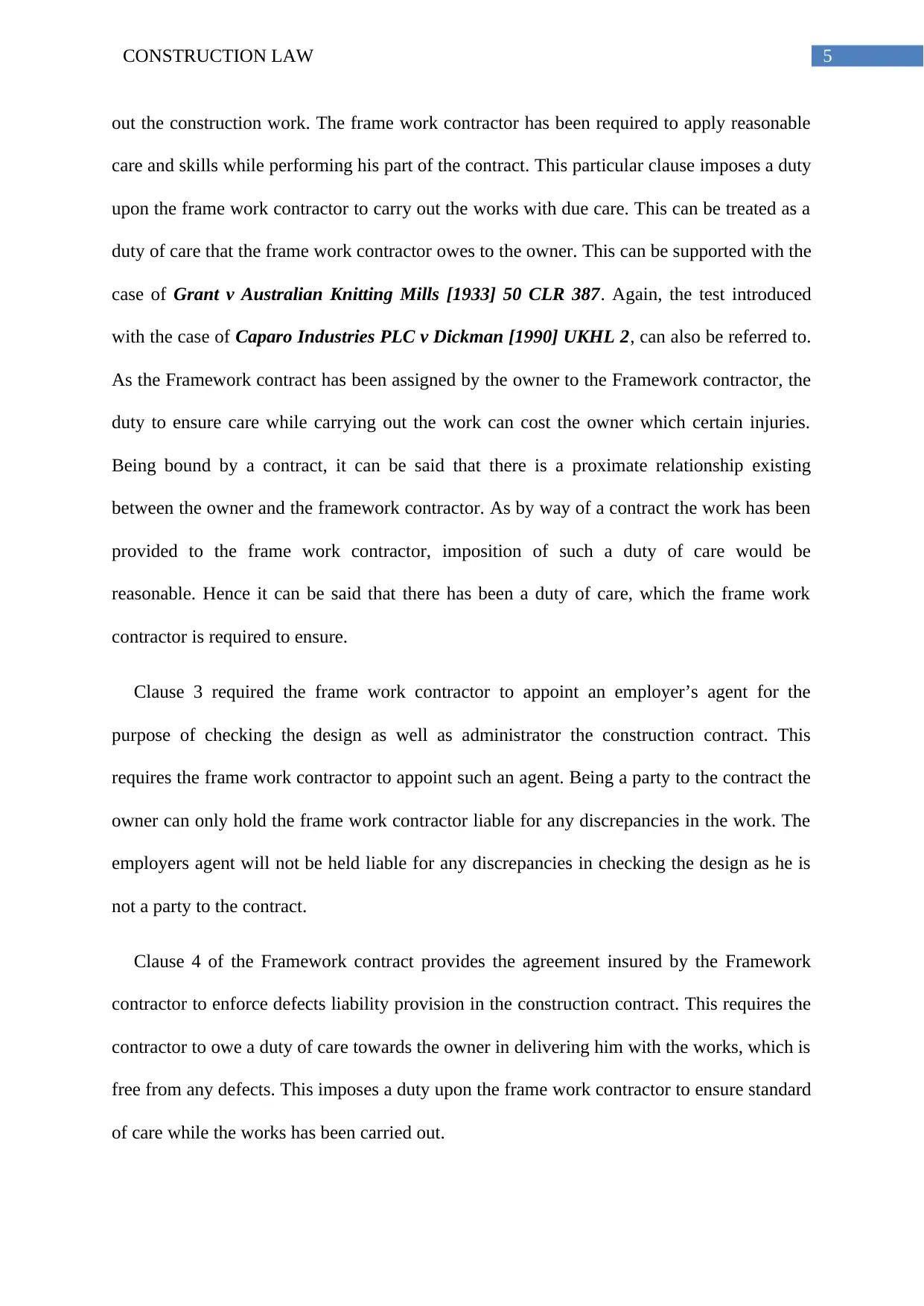
5CONSTRUCTION LAW
out the construction work. The frame work contractor has been required to apply reasonable
care and skills while performing his part of the contract. This particular clause imposes a duty
upon the frame work contractor to carry out the works with due care. This can be treated as a
duty of care that the frame work contractor owes to the owner. This can be supported with the
case of Grant v Australian Knitting Mills [1933] 50 CLR 387. Again, the test introduced
with the case of Caparo Industries PLC v Dickman [1990] UKHL 2, can also be referred to.
As the Framework contract has been assigned by the owner to the Framework contractor, the
duty to ensure care while carrying out the work can cost the owner which certain injuries.
Being bound by a contract, it can be said that there is a proximate relationship existing
between the owner and the framework contractor. As by way of a contract the work has been
provided to the frame work contractor, imposition of such a duty of care would be
reasonable. Hence it can be said that there has been a duty of care, which the frame work
contractor is required to ensure.
Clause 3 required the frame work contractor to appoint an employer’s agent for the
purpose of checking the design as well as administrator the construction contract. This
requires the frame work contractor to appoint such an agent. Being a party to the contract the
owner can only hold the frame work contractor liable for any discrepancies in the work. The
employers agent will not be held liable for any discrepancies in checking the design as he is
not a party to the contract.
Clause 4 of the Framework contract provides the agreement insured by the Framework
contractor to enforce defects liability provision in the construction contract. This requires the
contractor to owe a duty of care towards the owner in delivering him with the works, which is
free from any defects. This imposes a duty upon the frame work contractor to ensure standard
of care while the works has been carried out.
out the construction work. The frame work contractor has been required to apply reasonable
care and skills while performing his part of the contract. This particular clause imposes a duty
upon the frame work contractor to carry out the works with due care. This can be treated as a
duty of care that the frame work contractor owes to the owner. This can be supported with the
case of Grant v Australian Knitting Mills [1933] 50 CLR 387. Again, the test introduced
with the case of Caparo Industries PLC v Dickman [1990] UKHL 2, can also be referred to.
As the Framework contract has been assigned by the owner to the Framework contractor, the
duty to ensure care while carrying out the work can cost the owner which certain injuries.
Being bound by a contract, it can be said that there is a proximate relationship existing
between the owner and the framework contractor. As by way of a contract the work has been
provided to the frame work contractor, imposition of such a duty of care would be
reasonable. Hence it can be said that there has been a duty of care, which the frame work
contractor is required to ensure.
Clause 3 required the frame work contractor to appoint an employer’s agent for the
purpose of checking the design as well as administrator the construction contract. This
requires the frame work contractor to appoint such an agent. Being a party to the contract the
owner can only hold the frame work contractor liable for any discrepancies in the work. The
employers agent will not be held liable for any discrepancies in checking the design as he is
not a party to the contract.
Clause 4 of the Framework contract provides the agreement insured by the Framework
contractor to enforce defects liability provision in the construction contract. This requires the
contractor to owe a duty of care towards the owner in delivering him with the works, which is
free from any defects. This imposes a duty upon the frame work contractor to ensure standard
of care while the works has been carried out.
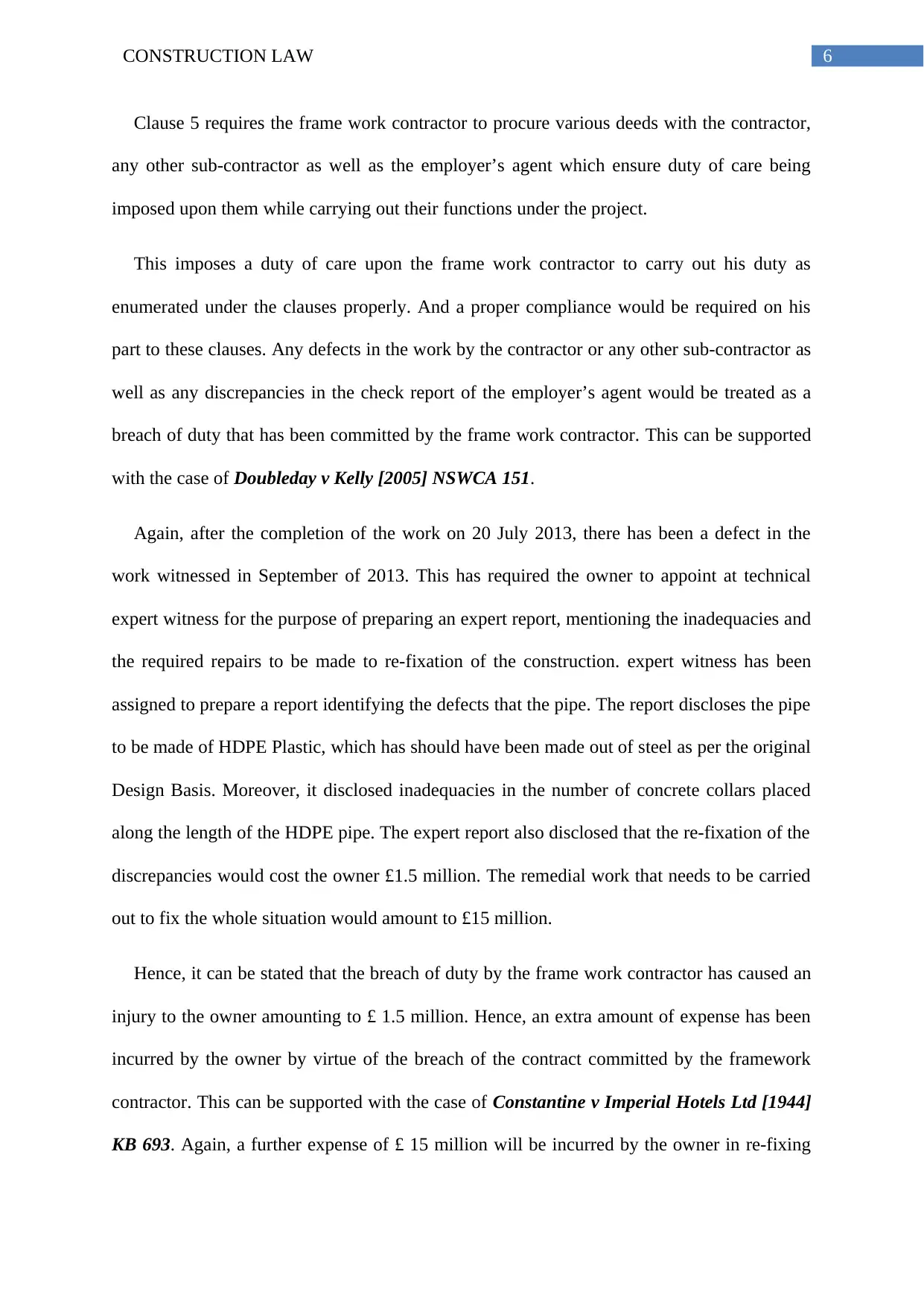
6CONSTRUCTION LAW
Clause 5 requires the frame work contractor to procure various deeds with the contractor,
any other sub-contractor as well as the employer’s agent which ensure duty of care being
imposed upon them while carrying out their functions under the project.
This imposes a duty of care upon the frame work contractor to carry out his duty as
enumerated under the clauses properly. And a proper compliance would be required on his
part to these clauses. Any defects in the work by the contractor or any other sub-contractor as
well as any discrepancies in the check report of the employer’s agent would be treated as a
breach of duty that has been committed by the frame work contractor. This can be supported
with the case of Doubleday v Kelly [2005] NSWCA 151.
Again, after the completion of the work on 20 July 2013, there has been a defect in the
work witnessed in September of 2013. This has required the owner to appoint at technical
expert witness for the purpose of preparing an expert report, mentioning the inadequacies and
the required repairs to be made to re-fixation of the construction. expert witness has been
assigned to prepare a report identifying the defects that the pipe. The report discloses the pipe
to be made of HDPE Plastic, which has should have been made out of steel as per the original
Design Basis. Moreover, it disclosed inadequacies in the number of concrete collars placed
along the length of the HDPE pipe. The expert report also disclosed that the re-fixation of the
discrepancies would cost the owner £1.5 million. The remedial work that needs to be carried
out to fix the whole situation would amount to £15 million.
Hence, it can be stated that the breach of duty by the frame work contractor has caused an
injury to the owner amounting to £ 1.5 million. Hence, an extra amount of expense has been
incurred by the owner by virtue of the breach of the contract committed by the framework
contractor. This can be supported with the case of Constantine v Imperial Hotels Ltd [1944]
KB 693. Again, a further expense of £ 15 million will be incurred by the owner in re-fixing
Clause 5 requires the frame work contractor to procure various deeds with the contractor,
any other sub-contractor as well as the employer’s agent which ensure duty of care being
imposed upon them while carrying out their functions under the project.
This imposes a duty of care upon the frame work contractor to carry out his duty as
enumerated under the clauses properly. And a proper compliance would be required on his
part to these clauses. Any defects in the work by the contractor or any other sub-contractor as
well as any discrepancies in the check report of the employer’s agent would be treated as a
breach of duty that has been committed by the frame work contractor. This can be supported
with the case of Doubleday v Kelly [2005] NSWCA 151.
Again, after the completion of the work on 20 July 2013, there has been a defect in the
work witnessed in September of 2013. This has required the owner to appoint at technical
expert witness for the purpose of preparing an expert report, mentioning the inadequacies and
the required repairs to be made to re-fixation of the construction. expert witness has been
assigned to prepare a report identifying the defects that the pipe. The report discloses the pipe
to be made of HDPE Plastic, which has should have been made out of steel as per the original
Design Basis. Moreover, it disclosed inadequacies in the number of concrete collars placed
along the length of the HDPE pipe. The expert report also disclosed that the re-fixation of the
discrepancies would cost the owner £1.5 million. The remedial work that needs to be carried
out to fix the whole situation would amount to £15 million.
Hence, it can be stated that the breach of duty by the frame work contractor has caused an
injury to the owner amounting to £ 1.5 million. Hence, an extra amount of expense has been
incurred by the owner by virtue of the breach of the contract committed by the framework
contractor. This can be supported with the case of Constantine v Imperial Hotels Ltd [1944]
KB 693. Again, a further expense of £ 15 million will be incurred by the owner in re-fixing
Paraphrase This Document
Need a fresh take? Get an instant paraphrase of this document with our AI Paraphraser
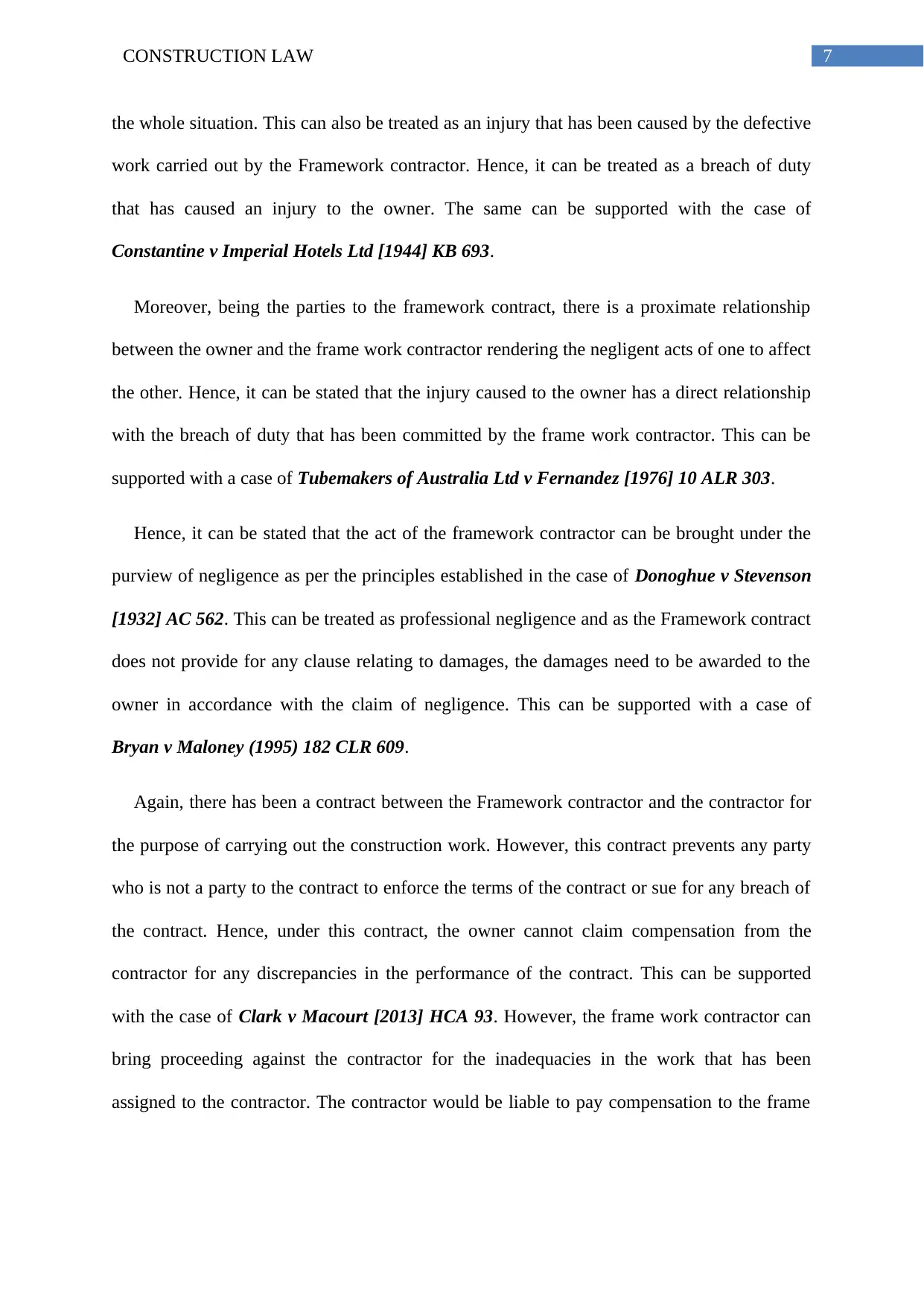
7CONSTRUCTION LAW
the whole situation. This can also be treated as an injury that has been caused by the defective
work carried out by the Framework contractor. Hence, it can be treated as a breach of duty
that has caused an injury to the owner. The same can be supported with the case of
Constantine v Imperial Hotels Ltd [1944] KB 693.
Moreover, being the parties to the framework contract, there is a proximate relationship
between the owner and the frame work contractor rendering the negligent acts of one to affect
the other. Hence, it can be stated that the injury caused to the owner has a direct relationship
with the breach of duty that has been committed by the frame work contractor. This can be
supported with a case of Tubemakers of Australia Ltd v Fernandez [1976] 10 ALR 303.
Hence, it can be stated that the act of the framework contractor can be brought under the
purview of negligence as per the principles established in the case of Donoghue v Stevenson
[1932] AC 562. This can be treated as professional negligence and as the Framework contract
does not provide for any clause relating to damages, the damages need to be awarded to the
owner in accordance with the claim of negligence. This can be supported with a case of
Bryan v Maloney (1995) 182 CLR 609.
Again, there has been a contract between the Framework contractor and the contractor for
the purpose of carrying out the construction work. However, this contract prevents any party
who is not a party to the contract to enforce the terms of the contract or sue for any breach of
the contract. Hence, under this contract, the owner cannot claim compensation from the
contractor for any discrepancies in the performance of the contract. This can be supported
with the case of Clark v Macourt [2013] HCA 93. However, the frame work contractor can
bring proceeding against the contractor for the inadequacies in the work that has been
assigned to the contractor. The contractor would be liable to pay compensation to the frame
the whole situation. This can also be treated as an injury that has been caused by the defective
work carried out by the Framework contractor. Hence, it can be treated as a breach of duty
that has caused an injury to the owner. The same can be supported with the case of
Constantine v Imperial Hotels Ltd [1944] KB 693.
Moreover, being the parties to the framework contract, there is a proximate relationship
between the owner and the frame work contractor rendering the negligent acts of one to affect
the other. Hence, it can be stated that the injury caused to the owner has a direct relationship
with the breach of duty that has been committed by the frame work contractor. This can be
supported with a case of Tubemakers of Australia Ltd v Fernandez [1976] 10 ALR 303.
Hence, it can be stated that the act of the framework contractor can be brought under the
purview of negligence as per the principles established in the case of Donoghue v Stevenson
[1932] AC 562. This can be treated as professional negligence and as the Framework contract
does not provide for any clause relating to damages, the damages need to be awarded to the
owner in accordance with the claim of negligence. This can be supported with a case of
Bryan v Maloney (1995) 182 CLR 609.
Again, there has been a contract between the Framework contractor and the contractor for
the purpose of carrying out the construction work. However, this contract prevents any party
who is not a party to the contract to enforce the terms of the contract or sue for any breach of
the contract. Hence, under this contract, the owner cannot claim compensation from the
contractor for any discrepancies in the performance of the contract. This can be supported
with the case of Clark v Macourt [2013] HCA 93. However, the frame work contractor can
bring proceeding against the contractor for the inadequacies in the work that has been
assigned to the contractor. The contractor would be liable to pay compensation to the frame
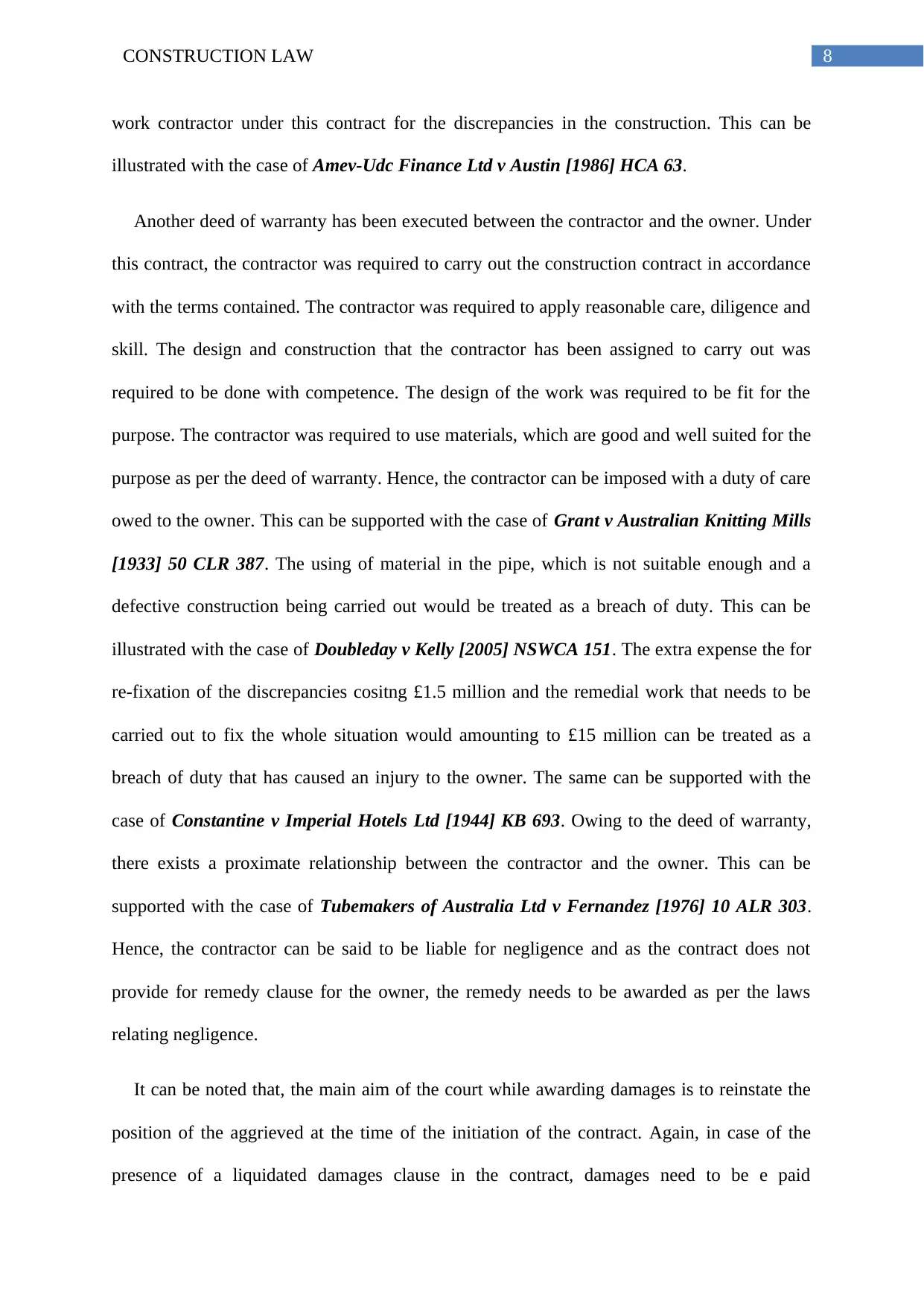
8CONSTRUCTION LAW
work contractor under this contract for the discrepancies in the construction. This can be
illustrated with the case of Amev-Udc Finance Ltd v Austin [1986] HCA 63.
Another deed of warranty has been executed between the contractor and the owner. Under
this contract, the contractor was required to carry out the construction contract in accordance
with the terms contained. The contractor was required to apply reasonable care, diligence and
skill. The design and construction that the contractor has been assigned to carry out was
required to be done with competence. The design of the work was required to be fit for the
purpose. The contractor was required to use materials, which are good and well suited for the
purpose as per the deed of warranty. Hence, the contractor can be imposed with a duty of care
owed to the owner. This can be supported with the case of Grant v Australian Knitting Mills
[1933] 50 CLR 387. The using of material in the pipe, which is not suitable enough and a
defective construction being carried out would be treated as a breach of duty. This can be
illustrated with the case of Doubleday v Kelly [2005] NSWCA 151. The extra expense the for
re-fixation of the discrepancies cositng £1.5 million and the remedial work that needs to be
carried out to fix the whole situation would amounting to £15 million can be treated as a
breach of duty that has caused an injury to the owner. The same can be supported with the
case of Constantine v Imperial Hotels Ltd [1944] KB 693. Owing to the deed of warranty,
there exists a proximate relationship between the contractor and the owner. This can be
supported with the case of Tubemakers of Australia Ltd v Fernandez [1976] 10 ALR 303.
Hence, the contractor can be said to be liable for negligence and as the contract does not
provide for remedy clause for the owner, the remedy needs to be awarded as per the laws
relating negligence.
It can be noted that, the main aim of the court while awarding damages is to reinstate the
position of the aggrieved at the time of the initiation of the contract. Again, in case of the
presence of a liquidated damages clause in the contract, damages need to be e paid
work contractor under this contract for the discrepancies in the construction. This can be
illustrated with the case of Amev-Udc Finance Ltd v Austin [1986] HCA 63.
Another deed of warranty has been executed between the contractor and the owner. Under
this contract, the contractor was required to carry out the construction contract in accordance
with the terms contained. The contractor was required to apply reasonable care, diligence and
skill. The design and construction that the contractor has been assigned to carry out was
required to be done with competence. The design of the work was required to be fit for the
purpose. The contractor was required to use materials, which are good and well suited for the
purpose as per the deed of warranty. Hence, the contractor can be imposed with a duty of care
owed to the owner. This can be supported with the case of Grant v Australian Knitting Mills
[1933] 50 CLR 387. The using of material in the pipe, which is not suitable enough and a
defective construction being carried out would be treated as a breach of duty. This can be
illustrated with the case of Doubleday v Kelly [2005] NSWCA 151. The extra expense the for
re-fixation of the discrepancies cositng £1.5 million and the remedial work that needs to be
carried out to fix the whole situation would amounting to £15 million can be treated as a
breach of duty that has caused an injury to the owner. The same can be supported with the
case of Constantine v Imperial Hotels Ltd [1944] KB 693. Owing to the deed of warranty,
there exists a proximate relationship between the contractor and the owner. This can be
supported with the case of Tubemakers of Australia Ltd v Fernandez [1976] 10 ALR 303.
Hence, the contractor can be said to be liable for negligence and as the contract does not
provide for remedy clause for the owner, the remedy needs to be awarded as per the laws
relating negligence.
It can be noted that, the main aim of the court while awarding damages is to reinstate the
position of the aggrieved at the time of the initiation of the contract. Again, in case of the
presence of a liquidated damages clause in the contract, damages need to be e paid
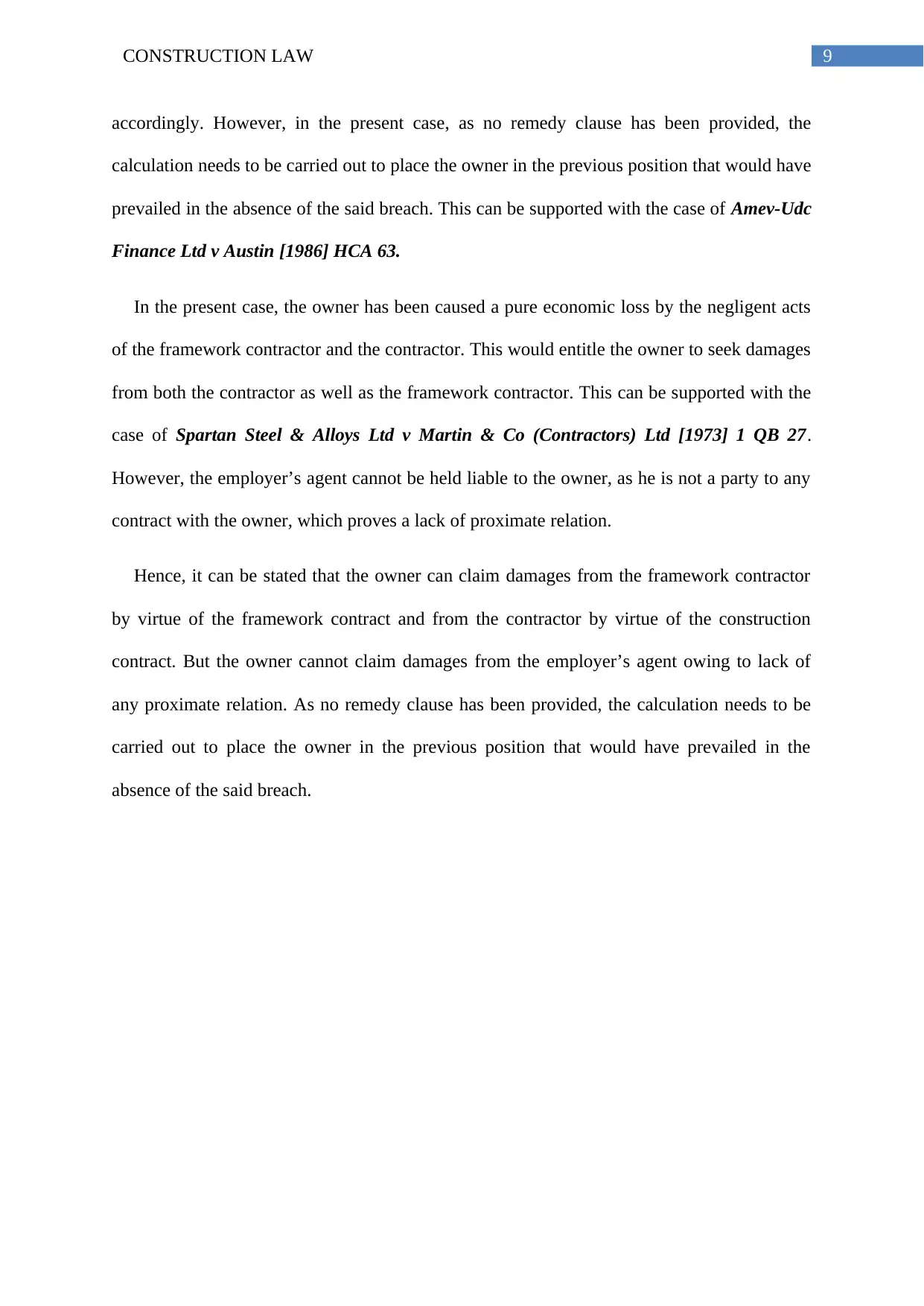
9CONSTRUCTION LAW
accordingly. However, in the present case, as no remedy clause has been provided, the
calculation needs to be carried out to place the owner in the previous position that would have
prevailed in the absence of the said breach. This can be supported with the case of Amev-Udc
Finance Ltd v Austin [1986] HCA 63.
In the present case, the owner has been caused a pure economic loss by the negligent acts
of the framework contractor and the contractor. This would entitle the owner to seek damages
from both the contractor as well as the framework contractor. This can be supported with the
case of Spartan Steel & Alloys Ltd v Martin & Co (Contractors) Ltd [1973] 1 QB 27.
However, the employer’s agent cannot be held liable to the owner, as he is not a party to any
contract with the owner, which proves a lack of proximate relation.
Hence, it can be stated that the owner can claim damages from the framework contractor
by virtue of the framework contract and from the contractor by virtue of the construction
contract. But the owner cannot claim damages from the employer’s agent owing to lack of
any proximate relation. As no remedy clause has been provided, the calculation needs to be
carried out to place the owner in the previous position that would have prevailed in the
absence of the said breach.
accordingly. However, in the present case, as no remedy clause has been provided, the
calculation needs to be carried out to place the owner in the previous position that would have
prevailed in the absence of the said breach. This can be supported with the case of Amev-Udc
Finance Ltd v Austin [1986] HCA 63.
In the present case, the owner has been caused a pure economic loss by the negligent acts
of the framework contractor and the contractor. This would entitle the owner to seek damages
from both the contractor as well as the framework contractor. This can be supported with the
case of Spartan Steel & Alloys Ltd v Martin & Co (Contractors) Ltd [1973] 1 QB 27.
However, the employer’s agent cannot be held liable to the owner, as he is not a party to any
contract with the owner, which proves a lack of proximate relation.
Hence, it can be stated that the owner can claim damages from the framework contractor
by virtue of the framework contract and from the contractor by virtue of the construction
contract. But the owner cannot claim damages from the employer’s agent owing to lack of
any proximate relation. As no remedy clause has been provided, the calculation needs to be
carried out to place the owner in the previous position that would have prevailed in the
absence of the said breach.
Secure Best Marks with AI Grader
Need help grading? Try our AI Grader for instant feedback on your assignments.
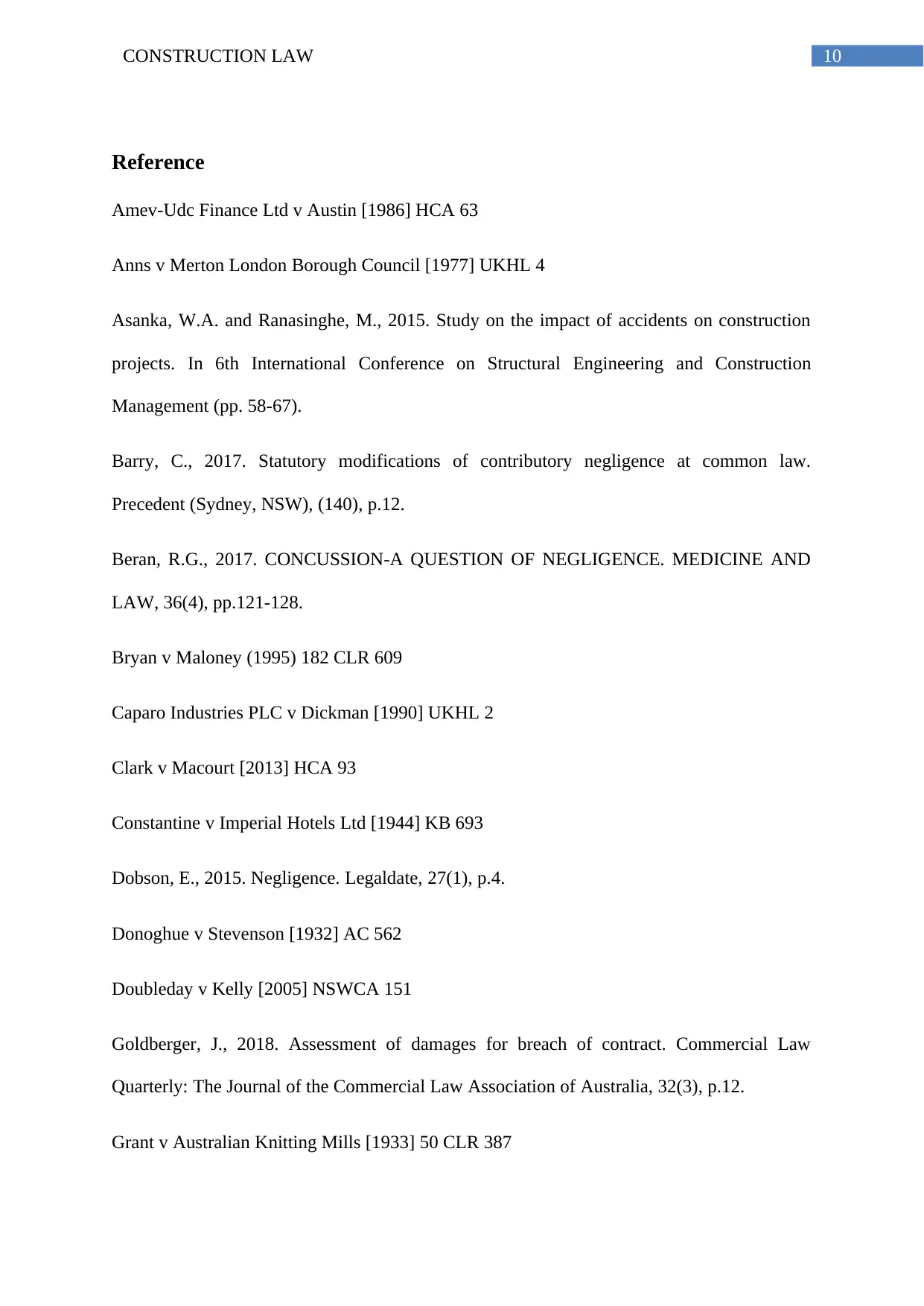
10CONSTRUCTION LAW
Reference
Amev-Udc Finance Ltd v Austin [1986] HCA 63
Anns v Merton London Borough Council [1977] UKHL 4
Asanka, W.A. and Ranasinghe, M., 2015. Study on the impact of accidents on construction
projects. In 6th International Conference on Structural Engineering and Construction
Management (pp. 58-67).
Barry, C., 2017. Statutory modifications of contributory negligence at common law.
Precedent (Sydney, NSW), (140), p.12.
Beran, R.G., 2017. CONCUSSION-A QUESTION OF NEGLIGENCE. MEDICINE AND
LAW, 36(4), pp.121-128.
Bryan v Maloney (1995) 182 CLR 609
Caparo Industries PLC v Dickman [1990] UKHL 2
Clark v Macourt [2013] HCA 93
Constantine v Imperial Hotels Ltd [1944] KB 693
Dobson, E., 2015. Negligence. Legaldate, 27(1), p.4.
Donoghue v Stevenson [1932] AC 562
Doubleday v Kelly [2005] NSWCA 151
Goldberger, J., 2018. Assessment of damages for breach of contract. Commercial Law
Quarterly: The Journal of the Commercial Law Association of Australia, 32(3), p.12.
Grant v Australian Knitting Mills [1933] 50 CLR 387
Reference
Amev-Udc Finance Ltd v Austin [1986] HCA 63
Anns v Merton London Borough Council [1977] UKHL 4
Asanka, W.A. and Ranasinghe, M., 2015. Study on the impact of accidents on construction
projects. In 6th International Conference on Structural Engineering and Construction
Management (pp. 58-67).
Barry, C., 2017. Statutory modifications of contributory negligence at common law.
Precedent (Sydney, NSW), (140), p.12.
Beran, R.G., 2017. CONCUSSION-A QUESTION OF NEGLIGENCE. MEDICINE AND
LAW, 36(4), pp.121-128.
Bryan v Maloney (1995) 182 CLR 609
Caparo Industries PLC v Dickman [1990] UKHL 2
Clark v Macourt [2013] HCA 93
Constantine v Imperial Hotels Ltd [1944] KB 693
Dobson, E., 2015. Negligence. Legaldate, 27(1), p.4.
Donoghue v Stevenson [1932] AC 562
Doubleday v Kelly [2005] NSWCA 151
Goldberger, J., 2018. Assessment of damages for breach of contract. Commercial Law
Quarterly: The Journal of the Commercial Law Association of Australia, 32(3), p.12.
Grant v Australian Knitting Mills [1933] 50 CLR 387
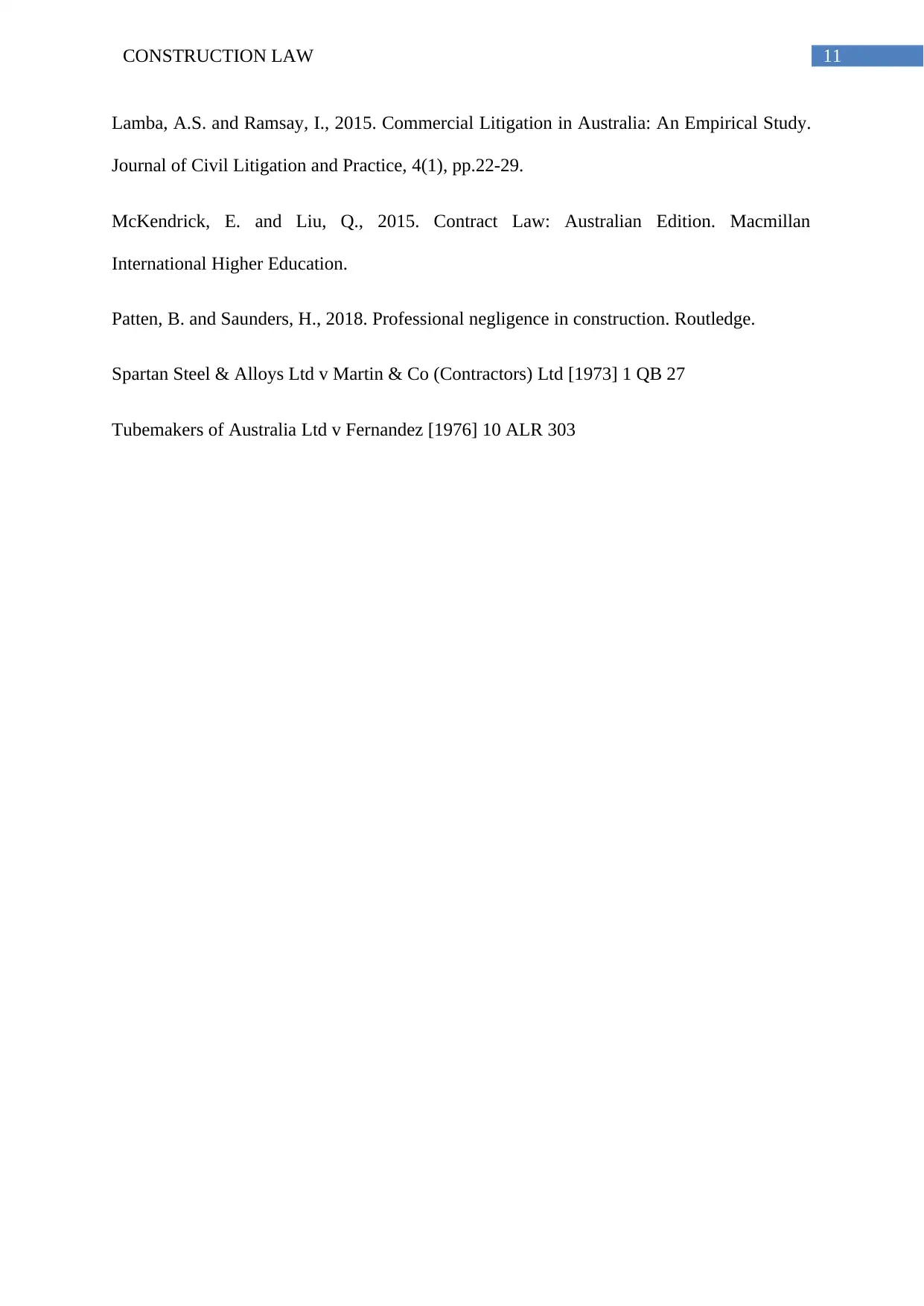
11CONSTRUCTION LAW
Lamba, A.S. and Ramsay, I., 2015. Commercial Litigation in Australia: An Empirical Study.
Journal of Civil Litigation and Practice, 4(1), pp.22-29.
McKendrick, E. and Liu, Q., 2015. Contract Law: Australian Edition. Macmillan
International Higher Education.
Patten, B. and Saunders, H., 2018. Professional negligence in construction. Routledge.
Spartan Steel & Alloys Ltd v Martin & Co (Contractors) Ltd [1973] 1 QB 27
Tubemakers of Australia Ltd v Fernandez [1976] 10 ALR 303
Lamba, A.S. and Ramsay, I., 2015. Commercial Litigation in Australia: An Empirical Study.
Journal of Civil Litigation and Practice, 4(1), pp.22-29.
McKendrick, E. and Liu, Q., 2015. Contract Law: Australian Edition. Macmillan
International Higher Education.
Patten, B. and Saunders, H., 2018. Professional negligence in construction. Routledge.
Spartan Steel & Alloys Ltd v Martin & Co (Contractors) Ltd [1973] 1 QB 27
Tubemakers of Australia Ltd v Fernandez [1976] 10 ALR 303
1 out of 12
Your All-in-One AI-Powered Toolkit for Academic Success.
+13062052269
info@desklib.com
Available 24*7 on WhatsApp / Email
![[object Object]](/_next/static/media/star-bottom.7253800d.svg)
Unlock your academic potential
© 2024 | Zucol Services PVT LTD | All rights reserved.

